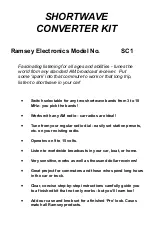
Slim Line
™
Power Inverters by Wagan Tech
®
9
www.wagan.com
© 2012 Wagan Corporation
All Rights Reserved
Wagan Tech and
wagan.com
are trademarks used by Wagan Corporation
User’s Manual—Read before using this equipment
10
INSTALLATION
Safe installation requires that a Battery Protection fuse is installed within one foot of
the positive (+) battery Terminal [red]. Use ANL marine fuses or equal because they
do not spark when they blow. Use an appropriate fuse holder for the fuse. ANL
fuse holders can be mounted so they do not move in a vehicle or vessel.
CONNECTING THE INVERTER
Loose DC (battery) connections will result in a severe voltage drop that can
cause damage to connectors, conductors, and insulation and can cause
sparking. Reverse polarity connection can permanently damage to the inverter.
Damage caused by reverse polarity will void the warranty.
WARNING:
Venting batteries produce explosive, corrosive gases. There is danger of
explosion. DO NOT connect or disconnect BATTERY cables directly after battery
discharge or recharge. Make sure that the battery bank area is well vented
before attaching or removing cables.
NOTES:
All recommended cable gauges and fuse sizes are located at the rear
of this manual in the Cable Gauge Table. The table describes Cable Gauges for
lengths greater than supplied cables.
“Round Trip” refers to actual cable distance in feet from the POS (+) battery
terminal through the inverter and back to the NEG (−) battery terminal.
Crimp-on ring terminals are required on all cable ends. The cable ends need to
be stripped of insulation for 1/2 inch before crimping on ring terminals. Select
a crimp terminal size to fit the cable gauge and inverter and battery terminal
connectors. After crimping, make sure that the cable connectors are secure on
the cables so there are no loose connections.
CAUTION:
Making an initial connection between the positive cable end and
the inverter’s positive terminal may cause a spark. This is normal and is a result
of capacitors in the inverter starting to charge. Because of the possibility of
sparking, it is extremely important that both the inverter and the battery bank be
positioned away from any source of flammable fumes or gases. Failure to heed
this warning can result in fire or explosion. Do not make the positive terminal
connection immediately after the batteries have been charging. Allow time for
the battery gasses to vent to outside air.
INSTALLATION PROCEDURE
1. Mount the inverter in a secure location. If the inverter is to be mounted on a
wall, mount it horizontally. Make sure that the front and rear of the inverter
has free air flow.
2. Make sure the cables are the proper gauge and have the fuse holder as
close to the battery bank’s Positive (+) terminal as possible.
3. Install the fuse in the Positive (+) cable (Refer to the Cable Gauge Table at
rear of manual).
4. Make sure the ON/OFF switch located on the front panel of the inverter is
in the OFF (O) position.
5. Connect the Negative (−) cable end to the inverter terminal and battery
Negative Terminal. Make sure you have good, secure connections.
6. Recheck and make sure the DC cable fuse is installed in the fuse holder.
7. Attach the positive cable to the Positive (+) DC connector on the battery
and then the inverter. Make sure the connections are tight and secure.
8. Turn on the inverter from the Front Panel ON/OFF Switch.
9. Make certain that the green Operating LED is lit and the red FAULT LED
indicator is not lit.
10. Turn OFF (O) the inverter. The Fault LED may briefly flash; this is normal.
The audible alarm may also sound a short chirp; this is also normal.
11. When you have confirmed that the appliance to be operated is turned
off, plug the appliance into one of the AC outlets on the front panel of the
inverter.
12. Turn the inverter on.
13. Turn the appliance on. The appliance should begin working.
14. Observe the LED indicators for normal operation.
If flooded lead acid batteries are used, be sure that periodic checks of battery
electrolyte levels are accomplished. Follow battery manufacturer’s instructions in
keeping the electrolytes at the proper level. Be sure to use pure distilled water when
replacing evaporated electrolyte liquid.





























